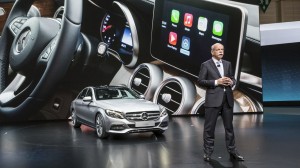CarPlay branches out to reach new generation
This week, Apple announced more details for CarPlay, a retrofitted iOS interface that would link your phone with the dashboard of your car. Perhaps more exciting than the interface itself was the crop of auto partners that will be using the feature: Ferrari, Honda, Hyundai, Mercedes-Benz and Volvo announced that CarPlay will be in their cars in 2014, with just about every other major auto company expected to follow with their own.

Beep beep · Apple CarPlay, originally announced at Apple’s 2013 WWDS conference, attempts to reach out to a new generation progressively changing from normal car culture. The new feature will be featured in Ferrari, Mercedes-Benz and Volvo models. – Photo courtesy of Cliccar
With a little less fanfare, Samsung announced that they are developing their own auto-interface called Drive Link, with the Indian auto company Tata Motors being the first to use it. Its most notable feature will be the ability to start a car with the Samsung Galaxy Gear (for the Batman in all of us).
Though Samsung has expanded its products into other industries, this is a different approach on Apple’s part, which has never really been so directly involved in a non-computer industry outside of brief flirtations such as with Nest (which now belongs to Google). So why such a bold entrance into an industry that it’s never been in before?
The truth of the matter is likely more literal: Apple doesn’t need to be in the auto industry as much as the auto industry needs Apple to be in it.
The fact is that not only are people not buying new vehicles, but more and more people are either choosing not to drive or are driving less. Though there are a number of factors ranging from the recession to the still-crippling price of gas (which has creeped back over $4 in the general Los Angeles area), another factor is that it’s a cultural transition. With more people living in the city, folks are relying more on riding the Metro, walking, and biking to get around town.
Nearly every public infrastructure initiative that’s occurred in Los Angeles recently has been a means of making the town more walking-friendly, diminishing traffic and decreasing the carbon footprint of automobiles. Though it’s been an excruciatingly long process, by the end of the decade, the Metro will have expanded in a such a way that someone living in Santa Monica could take a train to Pasadena, or someone from North Hollywood could ride to Long Beach without switching lines and a person near the Ontario Airport could take a rail to LAX if need be.
Nowhere is it more apparent that U.S. culture is shifting away from vehicular dependence than with the younger generation: The University of Michigan found that only 69.5 percent of 19-year-olds had acquired their drivers’ licenses in 2010, compared to 87 percent in 1983, with many saying their reason was either that the cost of maintaining a vehicle was too high or that they’d rather just walk or ride a bike.
So with many young people not even acquiring licenses, the auto industry is faced with a huge conundrum of trying to sell new vehicles in the face of such a fundamental cultural shift. A touch-based interface in your car isn’t anything new; however, by associating with the iOS interface, the ability to directly sync your contacts, music and locational information, all powered by Siri, seems to be a more convenient alternative than trying to use your phone when you’re driving.
The car industry is trying to make people excited to use a car — which seems like a superficial purpose, but it’s critical. A car used to be a symbol of social status, and though a nice car is still a good thing to possess, it’s seen as a commodity — not a required asset of your identity. Instead of developing their own interface, partnering with Apple and Samsung makes the transition easier.
Of course, a reliable interface will become all the more important for auto companies as it builds towards the next big trend: self-driving vehicles. With companies progressively getting the necessary legal approval for automated vehicles, a person’s ability to get into a car, have their phone sync up automatically and have the car drive them to a destination without so much as touching the wheel is going to be a major selling point. Making the car the pinnacle of technological ingenuity once again is likely the only, and best, way to convince a person to purchase a new vehicle.
Robert Calcagno is a graduate student studying Animation. His column, “Tech Talk,” runs Mondays.

